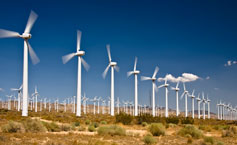Partnering with Renewables

FOR MORE INFORMATION
NATURAL GAS: A NATURAL PARTNER WITH RENEWABLES
One of the biggest advantages of using natural gas to generate electricity is its ability to be paired with renewable sources of energy, such as wind and solar. Because generating power from the sun and wind is limited by weather conditions (when the sun is shining or wind is blowing), power generated from natural gas provides an essential complement to maintain a steady flow of power to end users.
Two types of natural gas plants may backstop renewables. One is based on a traditional simple cycle generator which produces electricity when a combustion gas turbine is driven by a flow of hot gases. As air enters the gas turbine and mixes with natural gas it ignites, causing an increase in temperature, velocity and volume of natural gas flow. The flow of gas is directed through a nozzle to spin the turbine blades.
Simple cycle power plants are not very efficient though. The gas turbines are only able to use a portion of the heat generated from the flow of combustion gas. Combined cycle plant use the extra heat to make steam and drive a second generator.
COMBINED CYCLE POWER PLANTS
In combined cycle plants, steam is created as the waste exhaust heat passes through a heat recovery steam generator, which boils the water into steam. The steam is sent to a steam turbine, where the steam’s pressure spins the turbines. Additional electricity is produced resulting in improved efficiency and generating capacity.
And the second steam-fed generator makes these plants ideal for backing intermittent uses. Here’s why: Any steam that is not used in the turbine process leaves the turbine at a pressure and temperature low enough to turn the steam back into water for future use. This allows combined cycle power plants to quickly ramp up power again. Moreover, combined cycle plants produce lower NOx and carbon monoxide emissions when the waste heat passes through emissions reduction controls in the heat recovery steam generator process.
CALIFORNIA PROJECT
One example of the partnership between combined cycle gas generation and renewables involves an 800MW wind farm near Palm Springs, California. In October 2009, state legislation was signed clearing one of the final roadblocks to the gas-fired CPV Sentinel Power Project.
CPV Sentinel is a quick-start power plant that will use eight GE LMS-100 turbines, designed to start in only 10 minutes. The turbines will assist in reducing carbon dioxide emissions because they will be an estimated 10-15 percent more efficient than the next best plant in California today. The plant will also allow for the retirement of older, inefficient facilities that power the Coachella Valley.
OTHER PROJECTS
Another project that pairs natural gas with wind is planned near Great Falls, Mont. The Southern Montana Electric and Transmission Cooperative’s Highwood Generating Station was originally planned as a coal-fired plant. But the cooperative decided in January to build a natural gas plant with wind turbines for additional power, citing regulatory uncertainty and environmental lawsuits. The $206 million, 250 megawatt plant will have an additional 6 megawatts of wind capacity. State approval for the project came through in October, but the cooperative won’t comment on when construction will begin.
Officials planning the world’s largest solar project, a $10 billion, array in India with a capacity of up to 3,000 megawatts, also plan to use natural gas as fuel. The project will get logistical and financial support from the William J. Clinton Foundation, a charitable organization founded by the former president.
